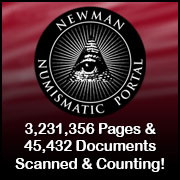|
About Us
The Numismatic Bibliomania Society is a non-profit association devoted to the study and enjoyment of numismatic literature. For more information please see our web site at coinbooks.org SubscriptionsThose wishing to become new E-Sylum subscribers (or wishing to Unsubscribe) can go to the following web page link MembershipThere is a membership application available on the web site Membership Application To join, print the application and return it with your check to the address printed on the application. Print/Digital membership is $40 to addresses in the U.S., and $60 elsewhere. A digital-only membership is available for $25. For those without web access, write to: Charles Heck, Treasurer AsylumFor Asylum mailing address changes and other membership questions, contact Chuck at this email address: treasurer@coinbooks.org SubmissionsTo submit items for publication in The E-Sylum, write to the Editor at this address: whomren@gmail.com BUY THE BOOK BEFORE THE COIN |
- WAYNE'S WORDS: THE E-SYLUM FEBRUARY 7, 2021
- KOLBE & FANNING RICHARD MARGOLIS LIBRARY SALE
- NEW BOOK: GUIDE BOOK OF GOLD EAGLE COINS, 2ND
- NEW BOOK: A GUIDE TO THE GUINEA 1663 TO 1813
- NEW BOOK: FOOD STAMP CREDIT TOKENS
- NEW BOOK: TRADE TOKENS OF NEWFOUNDLAND
- NEW BOOK: BILLETS EN GUERRE 1938-1948
- NEW PERIODICAL: THE LOUPE
- HENRY JOSEPH LEVINE (1940-2021)
- NEWMAN PORTAL SCANS NUMISMATIC NEWS
- VIDEO: MEDALLIC WORKS OF CHARLES BARBER
- AUDIO: HOW YEOMAN CHANGED COIN COLLECTING
- $10 DESERET CURRENCY PLATE DISCOVERED
- NOTES FROM E-SYLUM READERS: FEBRUARY 7, 2021
- SILVERED 1896 INDIAN CENTS
- VOCABULARY TERM: COLLECTOR'S MARK
- FREDERICK CHARLES COGSWELL BOYD (1884-1958)
- MCLACHLAN'S CANADIAN COMMUNION TOKENS
- ENGRAVER HENRY W. PAGE
- U.S. MINT UNABLE TO MEET BULLION DEMAND
- MARY LANNIN TO CHAIR CCAC
- HUNTER COLLECTION THIRTEEN COLONIES SETS
- HOLABIRD FEBRUARY 2021 SWEETHEART SALE
- WORLD BANKNOTE AUCTIONS SALE 4 SELECTIONS
- NUMISMATIC NUGGETS: FEBRUARY 7, 2021
- BRAND-POGUE 1822 HALF EAGLE OFFERED
- LOUIS ELIASBERG'S BARBER HALF DOLLARS, PART III
- HOW MORGAN DOLLARS BECAME INDIAN RUPEES
- 1862 LINCOLN OSAGE INDIAN SILVER PEACE MEDAL
- 1881 LEADVILLE PRESENTATION SILVER INGOT
- INTERESTING BULK LOT MEDAL FINDS
- 1955 BELGIUM HOLOCAUST SURVIVOR MEDAL
- 1971 BLACK AMERICAN DAY MEDAL
- LOOSE CHANGE: FEBRUARY 7, 2021
Click here to read the thin version on the web
Click here to subscribe
Click here to access the complete archive
To comment or submit articles, reply to whomren@gmail.com
Content presented in The E-Sylum is not necessarily researched or independently fact-checked, and views expressed do not necessarily represent those of the Numismatic Bibliomania Society.
WAYNE'S WORDS: THE E-SYLUM FEBRUARY 7, 2021
 New subscribers this week include:
David Buehler, courtesy Eric Holcomb;
Larry Jewett, courtesy of Jeff Starck;
Timothy Shellenberger, courtesy of Jonas Denenberg;
Stanley Benedict,
Michael Kodysz, and
George Di Russo.
Welcome aboard! We now have 6,607 subscribers.
New subscribers this week include:
David Buehler, courtesy Eric Holcomb;
Larry Jewett, courtesy of Jeff Starck;
Timothy Shellenberger, courtesy of Jonas Denenberg;
Stanley Benedict,
Michael Kodysz, and
George Di Russo.
Welcome aboard! We now have 6,607 subscribers.
Thank you for reading The E-Sylum. If you enjoy it, please send me the email addresses of friends you think may enjoy it as well and I'll send them a subscription. Contact me at whomren@gmail.com anytime regarding your subscription, or questions, comments or suggestions about our content.
This week we open with a numismatic literature sale, five new books, a new periodical, the loss of a hobby stalwart, updates from the Newman Numismatic Portal, and more.
Other topics this week include Food Stamp credit tokens, Numismatic News, Charles Barber, R. S. Yeoman, F.C.C. Boyd, R. W. McLachlan, Mormon paper money, collector's marks, upcoming auctions, the 1822 Half Eagle, an 1862 Lincoln Indian Peace Medal, a holocaust survivor's medal, and Black American numismatics.
To learn more about the Richard Margolis library, trade tokens of Newfoundland, Joe Levine, a counterstamped Conder token, silvered 1896 Indian cents, communion tokens, Mary Lannin, engraver Henry W. Page, Franklin Cents, and how Morgan Dollars became Indian Rupees, read on. Have a great week, everyone!
Wayne Homren
Editor, The E-Sylum
KOLBE & FANNING RICHARD MARGOLIS LIBRARY SALE
In March Kolbe & Fanning will offer highlights from the numismatic library of dealer Richard Margolis. Here's the announcement. -Editor
Richard Margolis Library Sale March 6
 Kolbe & Fanning Numismatic Booksellers are proud to announce that we will be offering highlights from the important library of numismatic literature belonging to Richard Margolis at auction on Saturday, March 6, 2021. Richard Margolis was a highly esteemed dealer in world coins and an indefatigable researcher. Well known to many as the long-time organizer of the New York International Numismatic Convention, he was also heavily involved in the International Association of Professional Numismatists. His library covers the coins, medals and paper money of all times, but is especially important for numismatic works on the period of the French and American Revolutions. The 539-lot sale features books, auction catalogues and periodicals, as well as separate sections on numismatic art and archival materials.
Kolbe & Fanning Numismatic Booksellers are proud to announce that we will be offering highlights from the important library of numismatic literature belonging to Richard Margolis at auction on Saturday, March 6, 2021. Richard Margolis was a highly esteemed dealer in world coins and an indefatigable researcher. Well known to many as the long-time organizer of the New York International Numismatic Convention, he was also heavily involved in the International Association of Professional Numismatists. His library covers the coins, medals and paper money of all times, but is especially important for numismatic works on the period of the French and American Revolutions. The 539-lot sale features books, auction catalogues and periodicals, as well as separate sections on numismatic art and archival materials.
Some highlights of the sale include:

NEW BOOK: GUIDE BOOK OF GOLD EAGLE COINS, 2ND
Whitman has published a new edition of Dave Bowers' book on U.S. gold eagles. Here's the press release. -Editor
 Whitman Publishing announces the release of the updated second edition of A Guide Book of Gold Eagle Coins, volume 24 in its popular Bowers Series of numismatic titles. The 448-page book will be available March 2, 2021. It continues in the tradition of the Guide Book of Morgan Silver Dollars and other best-selling “Official Red Book” guides. The full-color volume will be available online (including at Whitman.com) and in bookstores and hobby shops nationwide for $29.95.
Whitman Publishing announces the release of the updated second edition of A Guide Book of Gold Eagle Coins, volume 24 in its popular Bowers Series of numismatic titles. The 448-page book will be available March 2, 2021. It continues in the tradition of the Guide Book of Morgan Silver Dollars and other best-selling “Official Red Book” guides. The full-color volume will be available online (including at Whitman.com) and in bookstores and hobby shops nationwide for $29.95.
As he did in the first edition, author and numismatic researcher Q. David Bowers combines the history of America’s $10 gold coins (minted 1795 to 1933) with coin-by-coin analysis, pricing in multiple grades, auction records, grading guides, and collecting tips to help enthusiasts build and enjoy their own set of gold eagles.
Bowers, nicknamed the “Dean of American Numismatics,” has been researching and writing about U.S. gold coins for more than 60 years. He has studied numismatic catalogs, periodicals, and books on gold coins. More importantly, he has personally examined hundreds of thousands of gold coins, many of them in the process of cataloging the most famous coin collections ever to cross an auction block.
THE BOOK BAZARRE
NEW BOOK: A GUIDE TO THE GUINEA 1663 TO 1813
Token Publishing is offering a new book: A Guide to the Guinea 1663 to 1813. -Editor
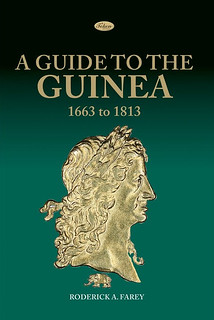 A Guide to the Guinea
A Guide to the Guinea
Roderick A. Farey
£29.95
Available now! The definitive guide to one of Britain's most famous coins! Covering the history of the Guinea from its beginnings in the reign of the newly restored monarch Charles II to its demise as a circulating coin and replacement by the modern sovereign in the time of George III, this book will tell you all you need to know about the "golden guinea" and all its varieties. A separate eight page Price Guide to the Guinea is also included with the book.

NEW BOOK: FOOD STAMP CREDIT TOKENS
A new book on Food Stamp Credit Tokens (also called 'Change Tokens') has been published. Congratulations to the authors! A tough subject to tackle. -Editor
 Food Stamp Credit Tokens, by Buckner Creel and John Ostendorf, is the first reference book on food stamp credit tokens in about 40 years. This reference book has over 500 pages of information with over 9,500 listings from all 50 states, the District of Columbia, Puerto Rico, Guam, and the U.S. Virgin Islands. Also included is the most information published to date on various manufacturers with photographs of stock reverses, including sub-varieties.
Food Stamp Credit Tokens, by Buckner Creel and John Ostendorf, is the first reference book on food stamp credit tokens in about 40 years. This reference book has over 500 pages of information with over 9,500 listings from all 50 states, the District of Columbia, Puerto Rico, Guam, and the U.S. Virgin Islands. Also included is the most information published to date on various manufacturers with photographs of stock reverses, including sub-varieties.
Food stamp credit tokens became a necessity during periods in which the U.S. government did not allow merchants to give change for their customers who paid with food stamps. The lowest denomination food stamp was 50 cents (later one dollar), so merchants had to fill the gap in order to provide correct change to their customers. Merchants used various means to provide change such as credit slips, scrip, punch cards, and tokens. Tokens became a popular means to provide change inexpensively while also providing advertising for the merchant. Most food stamp tokens were made of plastic by a few manufacturers that dominated the trade; however, food stamp tokens were also made of aluminum, brass, wood, and fiber.
NEW BOOK: TRADE TOKENS OF NEWFOUNDLAND
Eric Leighton of Nova Scotia has published a new book on the trade tokens of Newfoundland, Labrador, and Prince Edward Island. This article is republished here with permission from Canadian Coin News. Thanks. -Editor
 Nova Scotia collector, researcher and author Eric Leighton has published a limited-edition reference book for Newfoundland and Labrador plus Prince Edward Island tokens.
Nova Scotia collector, researcher and author Eric Leighton has published a limited-edition reference book for Newfoundland and Labrador plus Prince Edward Island tokens.
The 126-page hardcover book, The Trade Tokens of Newfoundland and Labrador & Prince Edward Island, is more than six years in the making.
Following the seven-page introduction, the book includes a checklist and index for both provinces’ tokens issued between 1867 and 2020. Each listing also includes a historical account with photographs, details of the tokens’ size, shape and composition plus any new research.
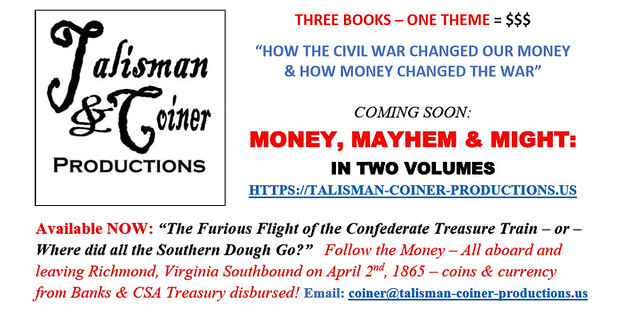
NEW BOOK: BILLETS EN GUERRE 1938-1948
A press release from the Banque de France announces a new book on emergency money in France during WWII. Here's a Google translation. Found via News & Notes from the Society of Paper Money Collectors (Volume VI, Number 33, February 2, 2021). -Editor
 "War Notes" by Jean-Claude Camus
"War Notes" by Jean-Claude Camus
1938-1948
Preface by François Villeroy de Galhau, Governor of the Banque de France
Unpublished documents from the collections of the Banque de France
This is a still unseen story from Seconde World War which is told in this book. That battles where banknotes clash of all the belligerents: invasion tickets imposed by the German army, relief tickets and reserve prepared by the Banque de France, banknotes of the free French to reconquer the territory, American banknotes from the Normandy landings then the Liberation ...
NEW PERIODICAL: THE LOUPE
Timothy Shellenberger submitted this invitation to his new newsletter, The Loupe. Good luck! See the link below to subscribe. -Editor
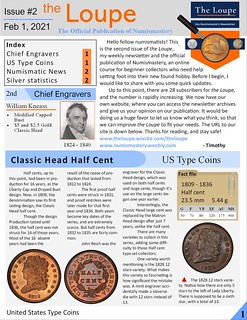 A New Weekly Numismatic Newsletter!
A New Weekly Numismatic Newsletter!
On January 26, the first issue of my weekly numismatic newsletter kicked off! As a numismatist like you, I understand how important it is to be continuously learning about all the different aspects of the hobby. To help you keep on learning, I decided to create my own weekly newsletter, delivered straight to your inbox! Each issue includes a spotlight on a United States type coin, a short profile on a Chief engraver, the latest numismatic news, silver coin melt values, and even a special “Guess the Grade” segment. And best of all, it’s free to sign up!

HENRY JOSEPH LEVINE (1940-2021)
We lost another hobby stalwart this week - medal dealer Joe Levine. He was a member of my Northern Virginia numismatic social group Nummis Nova, and will be greatly missed. Born April 15, 1940, he was 80 years old. Here's Pete Smith's entry for Joe on his American Numismatic Biographies book. -Editor
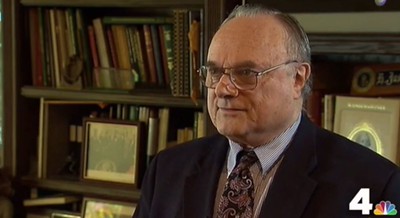 Born in Lock Haven, Pennsylvania. Received B.S. from Lehigh University in 1962, LL.B. from George Washington University in 1965, LL.M. from Georgetown University in 1966 and MBA from American University in 1969. He taught as assistant professor of law at the American University in Washington, D. C. Married to Alice H. Hawes October 15, 1988. He has a daughter from a previous marriage.
Born in Lock Haven, Pennsylvania. Received B.S. from Lehigh University in 1962, LL.B. from George Washington University in 1965, LL.M. from Georgetown University in 1966 and MBA from American University in 1969. He taught as assistant professor of law at the American University in Washington, D. C. Married to Alice H. Hawes October 15, 1988. He has a daughter from a previous marriage.
Owner of Presidential Coin and Antique Company of Alexandria, Virginia, established in 1971. They joined with Bowers and Merena for the sale of the Julian Leidman and David Dreyfuss collections in 1986. Levine and Presidential conducted 83 auction sales 1969 through 2010.

NEWMAN PORTAL SCANS NUMISMATIC NEWS
Newman Numismatic Portal Project Coordinator Len Augsburger provided the following update on the digitization of Numismatic News. Thanks. -Editor
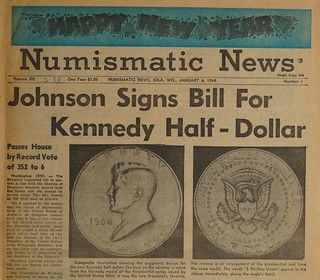 With the assistance of Cliff Mishler and George Cuhaj, Newman Portal continues to scan Numismatic News (1952-date). The reference set of this periodical is held by the Iola (WI) Historical Society, which has kindly loaned the run for scanning and permitted Newman Portal to unbind the volumes prior to scanning. To date, 1,368 issues have been scanned.
With the assistance of Cliff Mishler and George Cuhaj, Newman Portal continues to scan Numismatic News (1952-date). The reference set of this periodical is held by the Iola (WI) Historical Society, which has kindly loaned the run for scanning and permitted Newman Portal to unbind the volumes prior to scanning. To date, 1,368 issues have been scanned.
Illustrated here is the front page of the January 6, 1964 issue, announcing that Congress passed legislation, by an overwhelming margin, for the creation of the Kennedy half dollar. The concept design illustrated is markedly different from the actual coin, with smaller central figures on both sides.

VIDEO: MEDALLIC WORKS OF CHARLES BARBER
These are selections from the David Lisot Video Library that feature news and personalities from the world of coin collecting. David has been attending coin conventions since 1972 and began videotaping in 1985. The Newman Numismatic Portal now lists all David’s videos on their website at:
https://nnp.wustl.edu/library/multimediadetail/522852
Here's one on the medals of Charles Barber. -Editor
 Medallic Works of Charles Barber
Medallic Works of Charles Barber
Video Producer: David Lisot.
Speaker: Lawrence P. Baber.
Charles Barber designed some of America's most famous coins. Learn about other numismatic works that helped ensure this great sculptor's place in history. Delivered at the Florida United Numismatists in January 1996. Lecture with slides.
The video is available for viewing on NNP at:
https://nnp.wustl.edu/library/book/560344
AUDIO: HOW YEOMAN CHANGED COIN COLLECTING
The CoinWeek Podcast #150 is titled "How R.S. Yeoman Changed the Coin Collecting Hobby Forever." Check out the interview with Red Book Editor Emeritus Ken Bressett at the below link or on iTunes. -Editor
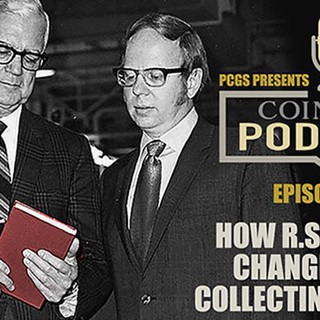 In this week’s episode of the CoinWeek Podcast, editor Charles Morgan talks to longtime Red Book editor Kenneth Bressett on the career and legacy of Red Book creator and coin board innovator R.S. Yeoman.
In this week’s episode of the CoinWeek Podcast, editor Charles Morgan talks to longtime Red Book editor Kenneth Bressett on the career and legacy of Red Book creator and coin board innovator R.S. Yeoman.
Yeoman’s ideas transformed the hobby from an academic pursuit to one with broad mainstream appeal. Whereas most numismatic books published before 1950 were printed in limited numbers, Yeoman’s Red Book was an instant success and has gone on to sell tens of millions of copies and is updated annually. This year, we will see the publication of its 75th edition.

$10 DESERET CURRENCY PLATE DISCOVERED
Douglas Nyholm published a great article in the Utah Numismatic Society Mint Master for February 2021 about the recent discovery of an engraving plate for a previously unknown $10 Deseret Currency Association note. It was originally published in the SPMC Paper Money journal last month. With permission, we're publishing an excerpt here. Thanks! -Editor
I was recently contacted and received an image of a $10 engraving plate from the Deseret Currency Association which was heretofore unknown. Presently printed notes from the second series of engraved notes were known only in the denominations of $1, $2, $3, and $5. There has never even been a rumor of any other denominations existing. Although this discovery item is the engraving plate, and no printed notes have yet come to light, it is a definite relic that at least plans were in place for a possible printing of this denomination.
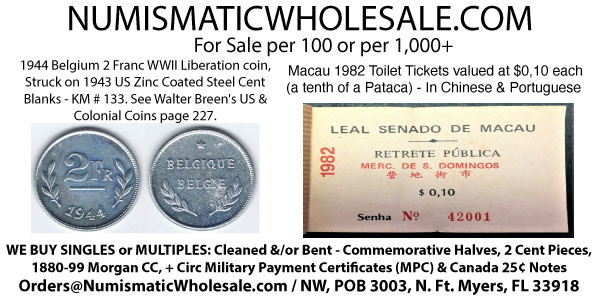
NOTES FROM E-SYLUM READERS: FEBRUARY 7, 2021
No Known Polymer £5 Note Counterfeits
Jonathan Callaway writes:
"I found the article RAID NETS UK'S LARGEST COUNTERFEIT SEIZURE very interesting. One unfortunate error in it is that the original report used the image of the current polymer £5 note, whereas the criminals had been counterfeiting the last paper £20 note, a very different situation indeed. There are no known examples of any of the new polymer notes being counterfeited and I think that should be made clear."
Good point. Thank you. Journalists aren't the best with numismatic details. I perpetuated the error, but that was the only image I had to work with in the article. I must see dozens and dozens of counterfeiting articles each week, and most are uninteresting stories of small-time crooks. The following article from Hong Kong was an example of that, and was included only because of the shared theme. The U.K. report was notable for the size of the haul and the sophistication of the counterfeiters. -Editor
To read the earlier E-Sylum articles, see:
RAID NETS UK'S LARGEST COUNTERFEIT SEIZURE
(https://www.coinbooks.org/v24/esylum_v24n05a27.html)
HONG KONG COUNTERFEIT BANKNOTES RISING
(https://www.coinbooks.org/v24/esylum_v24n05a28.html)
Other topics this week include coin whirligigs, Castorland jetons, and the Franklin Cent. -Editor

SILVERED 1896 INDIAN CENTS
Lev Linker noticed a reader inquiry in the November 23, 2020 Coin World about a nickel-colored 1896 Indian Cent. CW staff concluded that the silvery-looking piece was likely a normal worn cent that had been plated outside the mint. -Editor

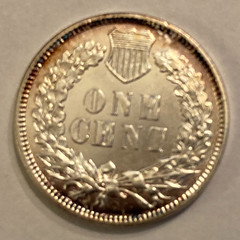
Lev writes:
"The silver-plated cent is from the Bryan presidential campaign of 1896. The cent is not listed in Fred Schornstein’s Bryan Money book; I suspect since it's not a minted token. I do not know how many of these are left, or just went into circulation and the plating quickly wore off."
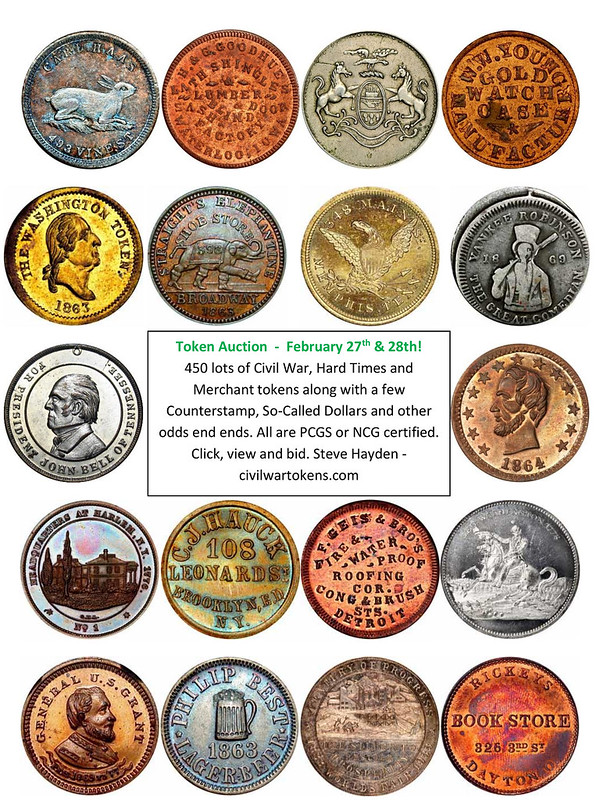
VOCABULARY TERM: COLLECTOR'S MARK
Here's another entry from Dick Johnson's Encyclopedia of Coin and Medal Terminology. -Editor
Collector's Mark. A type of hallmark applied by an owner to a numismatic or medallic item to prove ownership, such like a bookplate or an accession number. Perhaps in fear of theft collectors have inscribed, stamped or penned their initials, name, a number or symbol on numismatic items (usually on the edge). This is generally not appreciated by succeeding owners unless the figures or letters can be easily removed, or the owner is famous – in which case the mark remains intact. In recent years, collectors have marked their more valuable items with invisible ink (then it becomes identifiable under ultraviolet light).
In Poland during the 19th century and because of the chronic political unrest there, collectors marked their collections with collector's marks and the Morgenroth collection (#267) has such a collector's mark. But perhaps the most interesting collector's mark was used by J.P. Morgan who had medals in his personal collection pricked on the edge with seven tiny holes – in the shape of the Big Dipper and the North Star. Compare hallmarking, accession number.
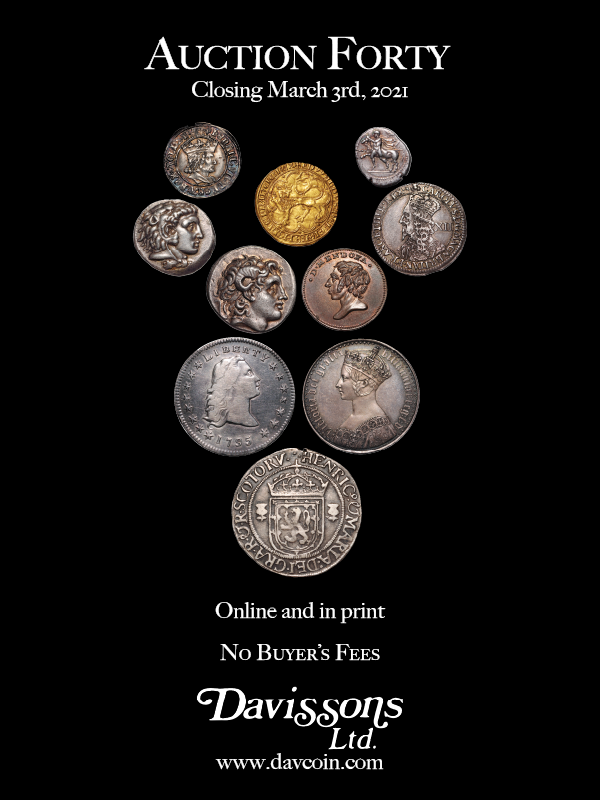
FREDERICK CHARLES COGSWELL BOYD (1884-1958)
Here's another entry from the online draft of John Lupia's book of numismatic biographies. Thanks! This week's subject is F. C. C. "Fred" Boyd. John's article is quite extensive and this is a short excerpt with the full article and bibliography available online. -Editor
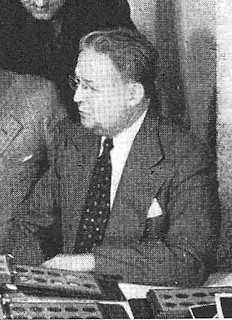 Boyd, Frederick Cogswell (1884-1958), Coin Dealer, Business Executive, Philanthropist.
Boyd, Frederick Cogswell (1884-1958), Coin Dealer, Business Executive, Philanthropist.
He was born in September 1884, in New York City, New York...
F. C. C. Boyd made his first appearance on the numismatic scene, in June 1912, when he applied for membership in the ANA.
In July 1912, he was elected to membership in the New York Numismatic Club, and exhibited an 1858 proof silver dollar. This was not an exceptionally rare coin, having more than 300 minted, but it did show not only his flair for high-grade coins from the outset but also his ability to attract attention by those who had such coins in their collections allowing him to network.
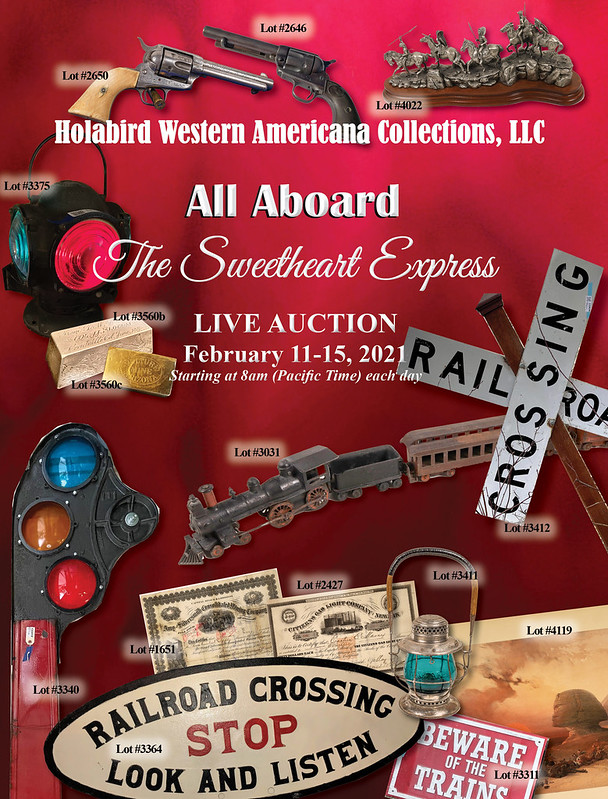
MCLACHLAN'S CANADIAN COMMUNION TOKENS
Howard R. Engel is the proprietor of Richard Stockley Books in Winnipeg, Manitoba, Canada, specializing in numismatic and philatelic literature. He recently inaugurated a new column on literature in Bison Tales, a publication of the Manitoba Coin Club. They and Howard kindly agreed to my request to republish the articles here in The E-Sylum. Thanks for sharing this. Items discussed are generally part of Howard's stock. All readers are welcome to do the same, offering a "show-and-tell" about interesting numismatic literature items in their library, duplicate file or stock. -Editor
Engel's Angle on Numismatic Literature
 Welcome back to my occasional column "Engel's Angle on Numismatic Literature". This month we are looking at another venerable leading pioneer of Canadian numismatics, this time "Canada's foremost collector and one of the leading numismatic scholars in the world", Robert Wallace (R. W.) McLachlan (1845-1926) and specifically his work Canadian Communion Tokens: A Catalogue of Metal Sacramental Tickets Used in the Different Presbyterian Churches in Canada. This work was originally published serially in 1889-1890 in the Canadian Antiquarian and Numismatic Journal and then first reprinted as a monograph in 1891. It has been reprinted in book form at least a couple of times since then.
Welcome back to my occasional column "Engel's Angle on Numismatic Literature". This month we are looking at another venerable leading pioneer of Canadian numismatics, this time "Canada's foremost collector and one of the leading numismatic scholars in the world", Robert Wallace (R. W.) McLachlan (1845-1926) and specifically his work Canadian Communion Tokens: A Catalogue of Metal Sacramental Tickets Used in the Different Presbyterian Churches in Canada. This work was originally published serially in 1889-1890 in the Canadian Antiquarian and Numismatic Journal and then first reprinted as a monograph in 1891. It has been reprinted in book form at least a couple of times since then.
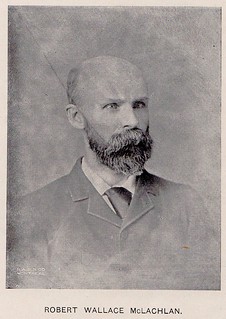 R.W. McLachlan, born in Montreal on March 9, 1845, began collecting at the young age of 12 in 1857 when copper coins circulating in Upper and Lower Canada consisted of a "hetergeneous collection of coins and tokens of many countries" that held out fascination and challenge for the observant young collector to find rare and attractive specimens. He certainly inherited a few of these upon receiving, through his mother, his maternal grandfather's collection of some dozen pieces amassed about a century before. The collection included "a Scottish six shilling piec of James VI, a copper one tari piece of Emanuel de Rohan of Malta, with the head of John the Baptist, and one or two 18th century trade tokens". In 1862 he had the opportunity to view the "well selected and extensively classified" coin cabinet consisting of some 3,000 pieces of Mr. J. L. Brondson, "one of the most ardent Montreal collectors of the time." This inspired McLachlan to build up his own collection, which had grown to about 150 pieces by then, with similar discriminating selection and organization into a coin cabinet, specializing in Canadian material. He paid attention to the accurate classification of each piece to better appreciate their intrinsic beauty, history and variety for the sake of education and exhibition, inventory and posterity.
R.W. McLachlan, born in Montreal on March 9, 1845, began collecting at the young age of 12 in 1857 when copper coins circulating in Upper and Lower Canada consisted of a "hetergeneous collection of coins and tokens of many countries" that held out fascination and challenge for the observant young collector to find rare and attractive specimens. He certainly inherited a few of these upon receiving, through his mother, his maternal grandfather's collection of some dozen pieces amassed about a century before. The collection included "a Scottish six shilling piec of James VI, a copper one tari piece of Emanuel de Rohan of Malta, with the head of John the Baptist, and one or two 18th century trade tokens". In 1862 he had the opportunity to view the "well selected and extensively classified" coin cabinet consisting of some 3,000 pieces of Mr. J. L. Brondson, "one of the most ardent Montreal collectors of the time." This inspired McLachlan to build up his own collection, which had grown to about 150 pieces by then, with similar discriminating selection and organization into a coin cabinet, specializing in Canadian material. He paid attention to the accurate classification of each piece to better appreciate their intrinsic beauty, history and variety for the sake of education and exhibition, inventory and posterity.
THE BOOK BAZARRE
ENGRAVER HENRY W. PAGE
Julia Casey submitted these notes regarding David Pickup’s request about the medallist H.W. Page. Thanks! -Editor
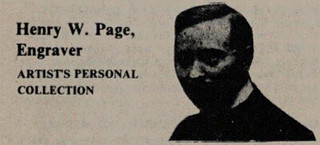 I searched the records at Ancestry.com and believe he is the same person as Henry William Page (b. May 6, 1882, d. Feb 1971). Page appears to have immigrated to Philadelphia in about 1914. He apparently went back to England at some point in the 1920s and then returned to Philadelphia in 1930, where he was naturalized as a US citizen in 1939.
I searched the records at Ancestry.com and believe he is the same person as Henry William Page (b. May 6, 1882, d. Feb 1971). Page appears to have immigrated to Philadelphia in about 1914. He apparently went back to England at some point in the 1920s and then returned to Philadelphia in 1930, where he was naturalized as a US citizen in 1939.
His World War I draft registration lists him as living at 1509 Girard Ave in Philadelphia. At that time he was employed as a die-sinker at J.E. Caldwell & Co at South Penn Square. In 1980 some of his personal collection was sold by Johnson & Jensen. The catalog is located on the Newman Numismatic Portal and there is a photograph of him along with the auction listings.
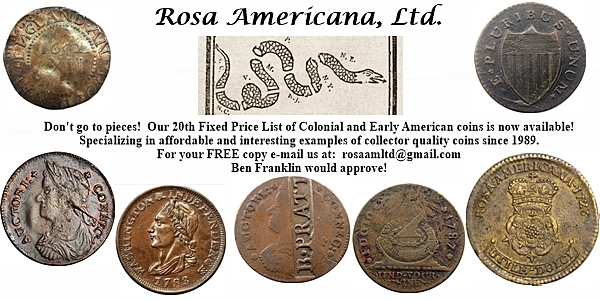
U.S. MINT UNABLE TO MEET BULLION DEMAND
This Reuters article discusses the Mint's problems meeting increased demand for bullion coins. -Editor
 The United States Mint said on Tuesday it was unable to meet surging demand for its gold and silver bullion coins in 2020 and through January, due partly to pandemic-driven demand and plant capacity issues.
The United States Mint said on Tuesday it was unable to meet surging demand for its gold and silver bullion coins in 2020 and through January, due partly to pandemic-driven demand and plant capacity issues.
Sales of U.S. gold bullion coins rose 258% in 2020 while silver coin demand was up 28%, the U.S. Mint said Tuesday. Heavy buying has continued in 2021, it said, squeezing supplies, which had already been tight as the coronavirus affected production.
A social media-driven buying spree lifted silver futures to an eight-year high on Monday, but dealers in the market for coins were already grappling with a supply shortage and shipping delays before that rally.
MARY LANNIN TO CHAIR CCAC
In a press release published February 3, 2021, the U.S. Mint announced the reappointment of Mary Lannin as Chairperson of the CCAC. -Editor
The United States Mint announced today that Mary N. Lannin has once again been appointed as the Chairperson of the Citizens Coinage Advisory Committee (CCAC) for a one-year term effective January 29, 2021. Ms. Lannin previously served as Chairperson from 2015 to 2018.
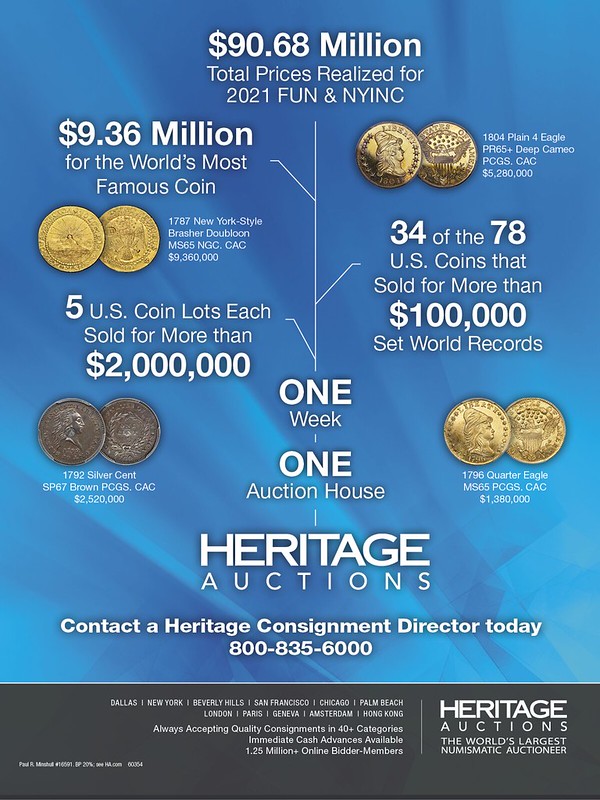
HUNTER COLLECTION THIRTEEN COLONIES SETS
Heritage guest cataloger Bruce Hagen submitted this final selection of highlights from the Hunter collection of U.S. colonial notes. Thanks! -Editor
The formation of thirteen colonies sets has been a popular pursuit for generations. Whether seeking to advance an existing collection or to embark on commencing a new one, collectors need to look no further than the Hunter Collection. This remarkable selection of colonial and Continental notes presents numerous opportunities to achieve a distinguished thirteen colonies set. All will be offered unreserved at auction on Thursday, February 11, 2021.
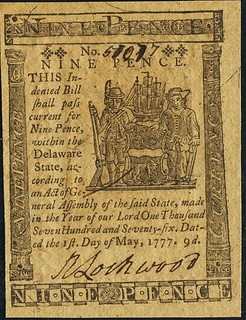

Delaware May 1, 1777 9 Pence Fr. DE-84 PCGS Gem New 65PPQ.
A handsome nine pence note with normal margins. Deeply embossed, with the sheaf of wheat on the back beautifully detailed. Lot 94079.

HOLABIRD FEBRUARY 2021 SWEETHEART SALE
Here's the press release for the Holabird Americana "Sweetheart Express" February 2021 sale. It only touches on the numismatic content, but I hope to have more detail in another article. -Editor
HOLABIRD WESTERN AMERICANA COLLECTIONS WILL KICK OFF 2021 WITH A SWEETHEART EXPRESS AUCTION, FEB. 11-15, ONLINE AND LIVE IN RENO, NEV.
Headlining the auction are two major collections: Gary Nelson (railroadiana) and Stewart “Scotty” MacKenzie (Montana mining). Nearly 4,000 premier lots will come up for bid.
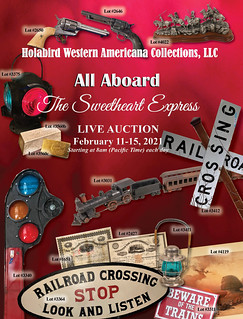 Already famous for its five-day monster auctions that feature thousands of lots in
a rainbow of collecting categories, Holabird Western Americana Collections will up the ante
with a Sweetheart Express Auction, also five days, from February 11th -15th , online and live in the
Reno gallery located at 3555 Airway Drive. The sale is bursting with nearly 4,000 premier lots.
Already famous for its five-day monster auctions that feature thousands of lots in
a rainbow of collecting categories, Holabird Western Americana Collections will up the ante
with a Sweetheart Express Auction, also five days, from February 11th -15th , online and live in the
Reno gallery located at 3555 Airway Drive. The sale is bursting with nearly 4,000 premier lots.
“The first sale of 2021 promises to be our best sale in several years – across the board – in every category,” said Fred Holabird, president and owner of Holabird Western Americana Collections. “We’ve been fortunate to receive many key collections to offer some of the best material to be sold in years. It may be the best cross-section of collectibles since the big market crash of 2008.”

WORLD BANKNOTE AUCTIONS SALE 4 SELECTIONS
Here are some lots that caught my eye in the World Banknote Auctions Sale 4, which closes on February 18, 2021. -Editor
Lot 4002: 1921 Angola 1 Escudo
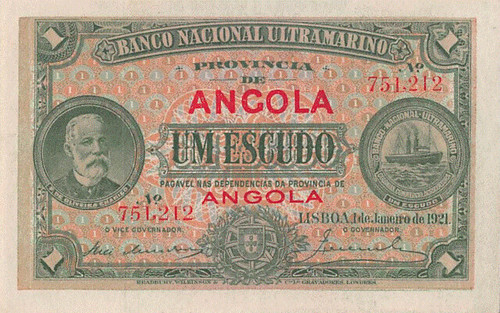
Angola 1.1.1921 P-55 PCGS Extremely Fine 45 PPQ 1 Escudo
Lightly circulated low denomination note from Angola. Like all Angola banknotes from this time period finding them in fully original condition with original paper is difficult.

NUMISMATIC NUGGETS: FEBRUARY 7, 2021
Here's a selection of interesting or unusual items I came across in the marketplace this week. Tell us what you think of some of these. -Editor
1900 Paris Exposition Medal
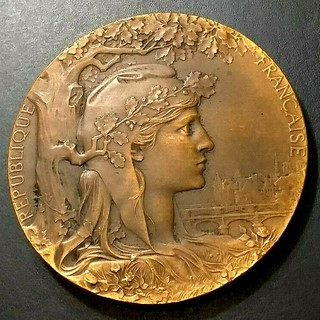
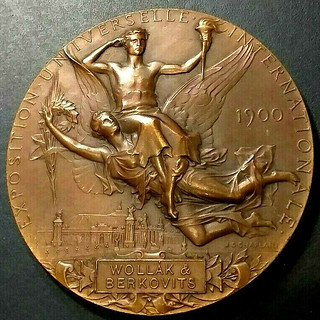
The Exposition Universelle of 1900, better known in English as the 1900 Paris Exposition, was a world's fair held in Paris, France, from 14 April to 12 November 1900, to celebrate the achievements of the past century and to accelerate development into the next. The fair, visited by nearly 50 million, displayed many technological innovations, including the Grande Roue de Paris Ferris wheel, the moving sidewalk, diesel engines, talking films, escalators, and the telegraphone (the first magnetic audio recorder). It also brought international attention to the Art Nouveau style. Additionally, it showcased France as a major colonial power through numerous pavilions built on the hill of the Trocadero Palace. Major structures remaining from the Exposition include the Grand Palais, the Petit Palais, the Pont Alexandre III, the Gare d'Orsay railroad station (now the Musée d'Orsay) and two original entrances of Paris Métro stations by Hector Guimard.
Found on eBay. -Editor
To read the complete lot description, see:
1900 Olympic Paris Rare French Art Nouveau medal to Jewish Company by Chaplain
(https://www.ebay.com/i/402585129538)
Other topics this week include a 1914-D Lincoln Cent, an 1808 Half Eagle, California Fractional Gold, and a hand-signed Joseph Barr note. -Editor

BRAND-POGUE 1822 HALF EAGLE OFFERED
The Brand specimen of the legendary 1822 half eagle, the only example in private hands, will be offered next month by Stack's Bowers. Here's the press release. -Editor
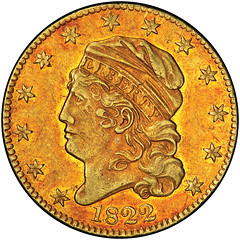
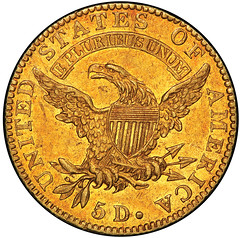
Stack’s Bowers Galleries will present at public auction the finest known 1822 half eagle, the D. Brent Pogue Collection coin. It is a legendary American treasure, the only example in private hands of what is acknowledged as the key to a collection of American gold coins. This exceptional coin will be featured in the firm’s March 23-26, 2021 auction in Las Vegas, Nevada.

LOUIS ELIASBERG'S BARBER HALF DOLLARS, PART III
Here's the third and final installment of Ron Guth's blog posts on the current whereabouts of Barber Half Dollars once owned by collector Louis Eliasberg. -Editor

Image courtesy PCGS.com
This is the third and final installment of a three-part series where I identify many of the Barber Half Dollars that were sold in 1997 as part of the Louis Eliasberg, Sr. collection. This installment will look at the dates from 1910 to 1915 and provide updated provenances for as many of the coins as possible.

HOW MORGAN DOLLARS BECAME INDIAN RUPEES
Jay Turner published a PCGS blog article January 29, 2021 based on an obscure fact found in William Silber's 2019 book, The Story of Silver - How Morgan dollars became Indian rupees. -Editor

India 1919 Calcutta Mint Rupee
Little thought is given by many on the previous incarnations of the metal that the coins they have once were. Yet, truth be told, the metallic content of many coins cannot be traced to their origins if their sources were previously melted coins – with some exceptions. One such exception entails the silver rupee coins from India, where many of the silver issues of George V after 1917 can trace their silver content back to the United States Morgan Dollar.

1862 LINCOLN OSAGE INDIAN SILVER PEACE MEDAL
Fred Holabird submitted this research on the 1862 Lincoln silver Peace Medal in his upcoming sale. Thanks! -Editor
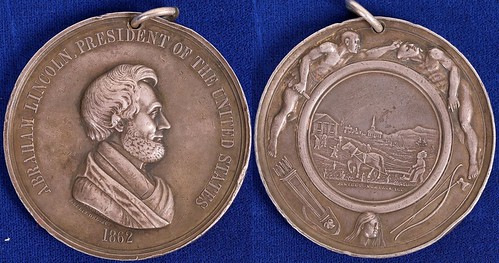
1862 Lincoln silver Peace Medal. 62.5 mm. About Uncirculated, with clean fields retaining mint luster, and only slight wear to the high points of Lincoln’s har. Virtually all of the hairlines are showing, something not seen on most of the other similar medals that have appeared at auction.

1881 LEADVILLE PRESENTATION SILVER INGOT
Fred Holabird also submitted this description of the 1881 Leadville Presentation Silver Ingot. Thanks. Fascinating item. -Editor
Leadville Presentation Silver Ingot, Cook to Slocum, 1881
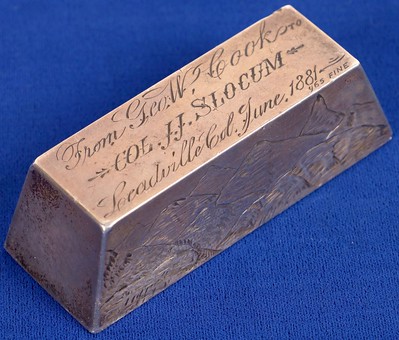 “From Geo. W. Cook to Col. J. J. Slocum Leadville Col June 1881 965 fine”. About 23 troy ounces, 3.5” long, 1 1/8” high and 1 3/8” wide, trapezoidal in the classic manner. No maker or assayer shown, as typical of a presentation ingot. This ingot was previously unknown to the writer, coming from a Boston family collection.
“From Geo. W. Cook to Col. J. J. Slocum Leadville Col June 1881 965 fine”. About 23 troy ounces, 3.5” long, 1 1/8” high and 1 3/8” wide, trapezoidal in the classic manner. No maker or assayer shown, as typical of a presentation ingot. This ingot was previously unknown to the writer, coming from a Boston family collection.
Exceptional engraved Leadville silver ingot – one of the three known different western precious metal ingots with an engraved mountain scene on it. This ingot is further important because it ties two great Americans- George W. Cook, a one-time Leadville Mayor, turned Colorado railroad magnate and Russel Sage, one of the wealthiest American railroad financiers.
George W. Cook (1851-1916) enlisted in the Indiana Voluntary Infantry at the age of 15 after running away from home. He was a regimental clerk and a drummer boy, a passion he kept his entire life. He went back to school after the war, moved to Chicago, where he took his first quality job with the Louisville & New Albany & Chicago Railroad. Somehow, that job led him to Leadville later that year where he joined Denver & Rio Grande Railroad as Division Superintendent. A popular man about town, Cook was elected Mayor of Leadville, serving from 1885-1887.
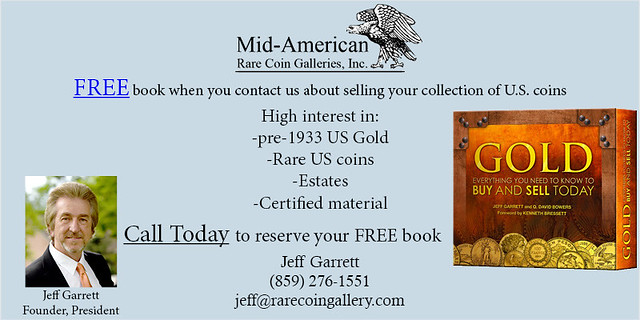
INTERESTING BULK LOT MEDAL FINDS
There are still nice finds to be had if one is willing to take a gamble on bulk lots. Here's an excerpt from the story of a collector who made some interesting finds. I like the pictured British Empire Exhibition medal. -Editor

1924 British Empire Exhibition medal
While trawling a certain auction website, I came across a large token collection at the starting price of 99p with £3 postage. There was over 1.5kg and I saw a few items I liked the look of so placed a bid of £5.67, strange bid I know but it has been a lucky for me before. I moved on and didn’t give it another thought. About 3 days later a ping when off on my phone and I had won, in the end paying the princely sum of £5.60 +£3 postage. I was happy enough and thought it would be a nice little lot to go through.

1955 BELGIUM HOLOCAUST SURVIVOR MEDAL
A holocaust survivor medal from Belgium was recently featured on the Antiques Roadshow. I was unaware these existed. -Editor
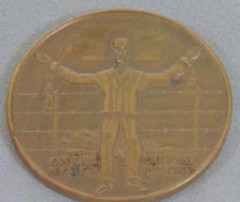

The antique fan asked the owner: “So I understand you have a mystery. You found something and you don’t know what it is. Where did you find it?”
The owner told: “Unfortunately my mum passed away in February this year and while we were sorting out her things we came across the medal that belonged to my grandad Tommy, which was her father.
“So it’s all been a bit of a mystery because we couldn’t find out why he actually got the medal.”
Mark then quizzed the owner's daughter, as he asked: “Do you know anything about it?”
“All I know is my great-grandad Tommy used to travel to Austen quite a lot but aside from that nothing,” she shared.
“Did he go often like maybe once a year? Some sort of a reunion of some description,” Mark suggested.
“We believe so,” the owner shared and the expert explained: “So the medal you’ve got is a medal that was made in 1955 and that’s when he’s been given this.
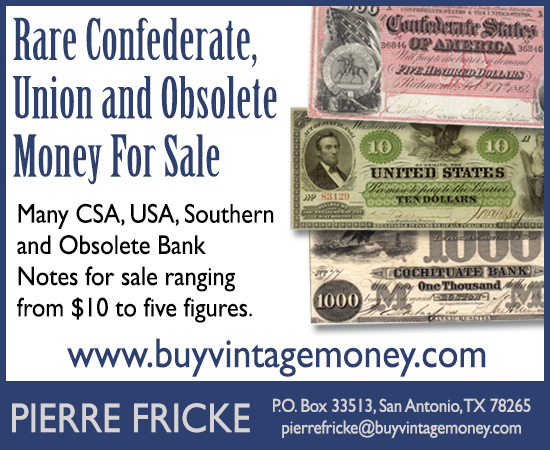
1971 BLACK AMERICAN DAY MEDAL
John Kraljevich posted the first of a planned series of Black History Month articles on Facebook this week. The first one highlights the 1971 Black American Day medal. I hadn't seen one of these before - thanks! -Editor
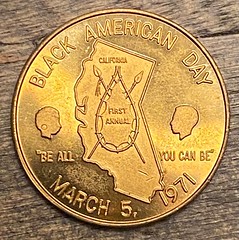
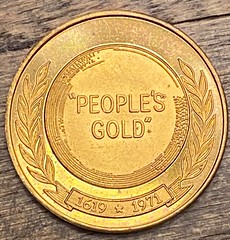
In 1971, California held its “first annual Black American Day” on March 5, 1971. This brass medal was struck to mark the occasion. The obverse shows the map of California superimposed with a stylized shield of Kenya’s Maasai people and the legend “Be All You Can Be.” On the reverse, the words “People’s Gold” is placed within a wreath with the dates 1619 and 1971. Yes, the date 1619, when the first Africans arrived in Virginia, has always held special meaning.
The California Black American Day holiday was conceived by Assemblyman Willie Brown, later mayor of San Francisco, in 1969, the year he was first elected to the California Assembly. He initially wanted the holiday to be celebrated on January 14, to mark Dr. Martin Luther King, Jr.’s birthday, but that idea failed to gain support. (King’s birthday became a Federal holiday in 1983.) More than a year later, Brown’s bill passed, with his Black American Day slated for March 5, the day Crispus Attucks, an African-American, was killed at the 1770 Boston Massacre. It was signed into law by Governor Ronald Reagan, who also signed the Martin Luther King, Jr. Day observance into Federal law as President, an ironic twist to the legacy of the man who gave a 1980 campaign speech on “states rights” at the Neshoba County Fair in Philadelphia, Mississippi, which was then famous for just one thing: a 1964 triple murder of civil rights activists.

LOOSE CHANGE: FEBRUARY 7, 2021
Here are some additional items in the media this week that may be of interest. -Editor
Lessen 'North York Moors' Collection Results
The Gazette & Herald published an article about the results of the Dix Noonan Webb sale of the Marvin Lessen 'North York Moors' collection of British coins. -Editor
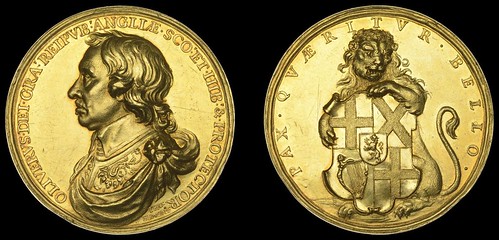
The collection, containing more than 520 rare and historic coins, has been sold in four parts over the past three years.
It belonged to collector Marvin Lessen who came to live in Scarborough in 1962 from America.
He spent his career in the aerospace and defence industries, working in various locations in Europe and North America.
Mr Lessen is known to have started collecting British coins when he arrived in Scarborough at the age of 28, having been born in Baltimore, Maryland, in 1934.
He worked across Europe and North America and had collected coins, stamps, arms and armour from an early age.
Mr Lessen was well known among coin dealers in London and the North East and renowned among collectors in Britain and America, writing many articles for the British Numismatist Journal.
To read the complete article, see:
https://www.gazetteherald.co.uk/news/19045897.north-york-moors-coin-collection-fetches-2-3m/
(https://www.gazetteherald.co.uk/news/19045897.north-york-moors-coin-collection-fetches-2-3m/)
Other topics this week include the 2021 World Money Fair, and Teutoburg Forest Coin Finds. -Editor






